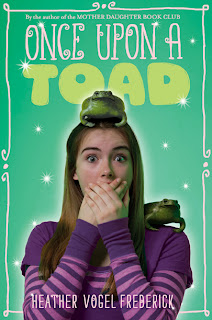Much Ado About Middle Grade:
Mastering Setting, Character & Plot
Heather Vogel Frederick
Sunday was the final workshop in the fifth season of the Northwest Author Series coordinated by Christina Katz and hosted by the Wilsonville Library. Although my focus is young adult fiction, the age brackets aren't necessarily clean cut. Each publisher has its own definition of "middle grade," which Frederick generalized as age 8 or 9 to 12. Any information I can acquire regarding young protagonists and readers is helpful.
Frederick is the author of the Mother Daughter Bookclub series. Her historical novel The Voyage of Patience Goodspeed received numerous awards including the 2003 Oregon Book Award for young adult literature.
Her newest book is a contemporary fantasy novel that is a whimsical spin on fairy tales.
After providing background on her own entry into published writing, Frederick indicated she enjoyed writing for middle graders because they are hungry for stories and retain a sense of wonder and willingness to go along for the ride.
Frederick described setting, character, and plot as the three legs of a stool. After discussing each element she gave participants a five-minute writing assignment before summarizing and moving on to the next element.
Setting is the anchor for the story. Frederick shared E. B. White's description of the barn from Charlotte's Web as an example of touching all the senses. Like J. K. Rowling in the the Harry Potter books and Ursula Le Guin's Earthsea series -- the author should transport the reader to the setting and set him or her down in the story world. The location should be tangible to the reader. Our writing exercise was to sketch a map of a favorite location from our childhood and then write a descriptive paragraph.
Character is the beating heart of the story. Harry Potter, Wilbur and Charlotte, and Scout from To Kill a Mockingbird are characters we embrace and flip pages to learn how they will get out of their scrapes. Frederick discussed what she called the Outside/In and Inside/Out methods of revealing character. Outside/in starts with the physical details and actions of the character that hint at the interior aspects. Inside/Out begins with the interior thoughts and emotions of the character. J. K. Rowling's descriptions of Harry Potter's aunt and uncle give the reader an excellent idea of their personalities. The opinions expressed in a piece of dialogue between the Mr. and Mrs. Bennett in Pride and Prejudice clearly exposes their character to the reader.
No plot, no story. Plot thrives on conflict and with so many available distractions young readers need something to happen quickly to pull them into the story. Frederick proposes asking "what if?" at all stages of writing a story. What if Patience didn't want to go on the ocean voyage with her father? Frederick referenced the classic three act structure described in detail by Christopher Vogler in The Writer's Journey and summarized it neatly:
- Act I: Character wants something
- Act II: Obstacles arise
- Act III: Climax and denouement
Frederick concluded by describing writing as an extreme sport. We need to sit in our chairs and write. We must silence our inner critic and recognize that even the most acclaimed authors had their work rejected many times before publication.
When asked about her writing process, Frederick indicated she is one of those who hates outlines. She will often begin her initial draft with pen and paper before moving to her computer to complete the first and subsequent drafts.
I have to admit, whenever I hear an author tell newbies that he or she doesn't use an outline it makes me cringe. The successful writer knows the plot points necessary for a good story, the newbies generally don't. I fear that they will muddle around in their story without signposts to keep them going in the right direction. I'm a convert to Larry Brooks' story architecture, but we all have our own approaches to the creative process. Whatever method works for each individual is valid.
Frederick shared with us several quotations during the workshop, including one of my favorites:
There are three rules for writing a novel. Unfortunately,
no one knows what they are.
Somerset Maugham



No comments:
Post a Comment